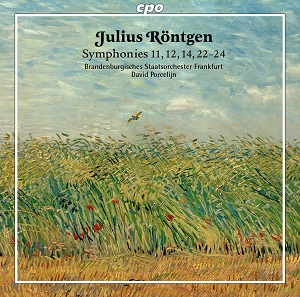
David Porcelijn brings fresh excitement to Rontgen symphonies
If you — like me — love the music of Julius Rontgen, then this release is a must-have. If you’re not familiar with this 20th Century Dutch composer, this release is a good place to start.
Röntgen was a major figure in Dutch musical life. As a pianist, he performed Brahm’s second piano concerto — with the composer conducting. He regularly accompanied Carl Flesch and Pablo Casals. He and his sons formed a piano trio that toured Europe to great acclaim.
And all the while he composed.
Röntgen had a natural gift for melody and harmony. His early works emulated those of his friend Brahms. But over time Röntgen adopted other techniques, always reworking them to fit his own style.
Röntgen wrote 25 symphonies, seven of which appear in this two-disc set. And, if you’re counting, it brings CPO’s total up to 19 recorded Röntgen symphonies.
The longest work on this release is Symphony No. 7, the “Edinburgh.” Röntgen wrote it in response to receiving an honorary degree from the University of Edinburgh. Haydn’s “Oxford” symphony was composed for a similar situation, and Röntgen took it as his model.
I can hear the influence. The symphony has a more transparent texture than most of Röntgen’s works. And it has a touch of academia as well. Röntgen shows off his compositional skill with some phenomenal fugal passages.
Röntgen wrote fast, but always with the highest quality. In 1930 he composed eight symphonies (including nos. 11 and 12 recorded here). And in 1931 he batted out another eight (included Symphony No. 22 presented here). His Symphony No. 11 in G minor was written in just two days.
These 1930s symphonies are short, single-movement works running 10-12 minutes. But they are symphonic in nature. Röntgen presents expansive themes that continually transform. And these are dense works, too. The full scope of Röntgen’s music is only revealed by repeated listening.
David Porcelijn has conducted eleven albums of Röntgen’s symphonic music for CPO. He knows Röntgen’s music intimately. And that’s what makes these performances so thrilling. Röntgen wrote in a post-Romantic style that isn’t quite like anybody else’s. Porcelijn brings out the unique qualities of Röntgen’s music. And that makes these symphonies sound fresh and exciting.
Only six symphonies to go. I’m ready!
Julius Röntgen: Symphonies 7, 11,12, 14, 22-24
Brandenburgisches Staatsorchester Frankfurt; Helsingborg Symphony Orchestra; David Porcelijn, conductor
CPO 777-309-2

